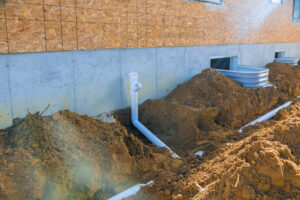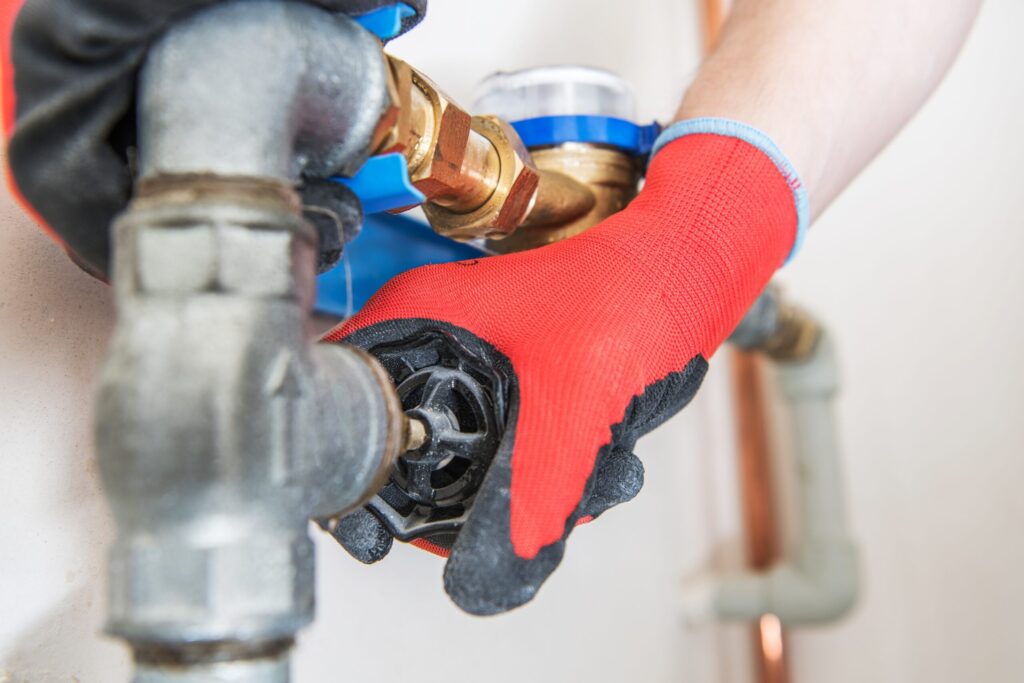Drain and Plumbing Systems
A drain pipe, trap, and vent are essential elements
of your home’s plumbing systems. Here’s what you need to know about each one.
The drainpipe carries waste water away from sinks, toilets, tubs, showers, etc., into the main sewer lines. A typical drainpipe is 2 inches in diameter and runs from the lowest part of the sink or bathtub to the basement. Traps capture water draining down the sink or toilet bowl and diverting it into the sewer line. Vents allow air to enter the building while preventing sewer gases from escaping.
Plumbing Provides Fresh Water
Many people don’t realize the importance of keeping your water system clean and working correctly. If you think plumbing problems are just something that happens far away, think again. If there is anything wrong with the plumbing inside your house, it could lead to serious health issues.
Water that gets stagnant over time takes up oxygen and creates bacteria in your pipes. This leads to mold growth and even worse things like black water flooding your basement. Your water supply is crucial to your well-being, so make sure you know what to look for.
Water Lines in Plumbing Systems
The best way to find the location of the water line is to start looking for the water meter outside the house. This is usually located near the main entrance. Next, locate the pipe entering the house. This is typically found inside the wall, under the floorboards, or behind the door frame. If you cannot locate the water meter, the next step is to check the utility bill for the address. Look for the name of the water provider and the meter number. You can use that information to determine whether the water line runs through the same area.
Drains Remove Waste Water
Think of drain issues as water coming into your house, like when you turn on the faucet and water goes into your pipes. For example, clogs in your kitchen sink could mean that food particles have built up over time, causing the pipes to become blocked. This causes wastewater to go down the drain, which is why your sink drains slowly.
If you don’t regularly check your sinks and toilets, you might notice that water is draining slower than usual. This is why it’s essential to keep your drains clean. You can use a plunger to clear clogged drains or hire a professional plumber to do the job.
Where Do Drain Systems Lead?
The plumbing system works like a giant funnel. Water flows out of the faucet, moves through pipes under your house, and ends up in a sewer pipe. Your kitchen sink drains wastewater from food preparation, bathroom sinks drain waste water from bathing, and toilets drain wastewater from human elimination. All three kinds of wastewater are called “wastewater.” Wastewater goes through the same process as drinking water. Wastewater travels through pipes and collects in large tanks called septic systems, where bacteria break down the solid material. This type of wastewater is called “sewage” and is usually treated before being discharged into local waterways.
Types of Drain Pipes
Home drains come in many different sizes, shapes, and materials. Some are even designed specifically to meet specific needs. For example, some are meant to handle wastewater while others are used to manage stormwater runoff.
The plumbing system in your house depends on when your piping was installed. Copper piping was once trendy because it is durable and easy to install. But over time, copper pipes become brittle and corrode, especially when exposed to air. This makes them less effective at carrying out the function of draining water.
Today, PVC is often the material of choice for installing drain pipes in new homes and remodeling older ones. It is strong and flexible, making it well suited for home plumbing systems. ABS plastic is another option for drain pipes. It is lightweight and resistant to damage, meaning it does not crack easily.

However, it is important to understand that although some types of drain pipes are better than others, none are perfect. While they can be repaired, they cannot always be replaced. So, when you notice problems with your home’s drainage system, it is best to contact a professional plumber.
Waste Water System
Waste water goes through pipes that flush the waste into a nearby sewer system. Your wastewater system comprises pipes that send sewage away from your house and vents that send gas away from your home. These pipes are usually large enough to allow the waste to travel far away from your house.
Pipes carrying the waste are called “sewage lines.” They carry the waste from different areas of your home or office to a central location like a septic tank, pit, or treatment plant. The farther away from your toilet or kitchen sink, the bigger your pipes must be to dispose of the waste.
Most sewer systems rely on gravity alone to move the waste to where it needs to be. Gravity helps keep the pipes clean of debris and helps prevent clogs.
When you flush the toilet or turn on the faucet, the waste flows down a pipe into a small chamber called a trap. Here, the waste is separated from the air. Air enters the trap via a tube called an overflow pipe. The waste stays inside the trap while the air exits another tube called a vent pipe.
The size of the trap depends on how much waste there is in your plumbing. A smaller trap collects less waste, so it empties faster. Larger traps collect more waste, so they drain slower.
Toilets and sinks are located near the center of most homes. As the waste moves toward the drains, the pipes change direction slightly to ensure that the waste leaves the area quickly. If the pipes are too close together, the waste will stop flowing because it cannot pass through both pipes simultaneously. To avoid this problem, pipes are angled so that they do not interfere with each other.
Traps
A trap is a device that prevents sewer gas from entering the home. Traps are usually found under sinks, showers, bathtubs, laundry rooms, and drains. They are located where there is a bend in the drain pipe. This bend allows water to flow down the drain while trapping sewer gas outside the building. In addition to preventing odors, traps keep the pipes clear of debris and help to maintain proper drainage.
Vent Pipe
The vent pipe’s primary purpose is to regulate the amount of air inside your plumbing system. Once installed, vents are typically found near bathrooms, kitchens, laundry rooms, and basements. They help prevent odors from building up in those areas’ walls, floors, and ceilings.
A vent pipe is usually located outside your home, in the wall or roof. The pipe connects to the interior of your home via a hole drilled through the exterior siding. This allows air to enter your home while preventing moisture from entering the wall cavity.
The plumbing vents we have discussed here are used to release gasses from the sewers. These vents are usually found near toilets, sinks, showers, bathtubs, and washing machines. They are placed along the walls of the building where there isn’t much space.
The pipes carry water vapor from inside your home to a drainpipe outside. These pipes often become clogged over time, causing a buildup of gases inside your home. If those gases aren’t removed, they’ll seep out of your home through cracks around doors and windows.
That’s where the vent pipe comes in. It’s installed away from your air conditioning units and windows, so the gases and odors don’t come back into your house.
P-Trap
The P-trap is a simple device that prevents sewer gas and backflow from entering your home. It’s a P-trap because it looks like a little “P” shape.
While there are many variations of traps, most look similar to this one. They are usually installed near drains where you want to prevent backflow and sewer gas from seeping back into your house.
A P-trap consists of three parts: a bend in the drainpipe, a trap chamber, and a cover plate.
Water flows quickly through the drainpipe when you flush the toilet or turn on the sink faucet. This creates suction, pulling air along with it. As the air rushes out of the drain, it pushes against the inside wall of the drainpipe, creating pressure.
This pressure builds until it reaches a certain level, pushing water back up the pipe. When the water hits the bend in the pipe, it slows down, allowing some of it to flow around the bend and into the trap chamber.
Once the water enters the trap chamber, it fills the space and creates a vacuum. Gravity pulls the water into the drainpipe, and the rest goes down the drain.
Now let’s talk about what happens when sewer gas or backflow enters the trap chamber. Because the water fills the entire volume of the trap chamber, the air can no longer escape. Instead, it stays trapped inside the trap chamber.
Drainpipes
Wastewater travels down the inside of your house via a system of pipes called a sewer line. Your sewer line starts where you flush toilets and ends in a larger pipe called the main sewer line. From there, the sewage flows into a secondary line called a lateral sewer line. This line leads to a third line called a tertiary line. Finally, the waste travels to a treatment plant, where it is cleaned up and put back into the environment.
Your home’s drainpipes are part of the sewer system. They transport wastewater away from your home. There are many different types of drainpipes used throughout the world. In North America, most homes use PVC drainpipes.
Lateral Connection
The lateral connection is the most critical part of your home’s plumbing system because it connects the smaller pipes. It is also the widest pipe in your home’s plumbing network. Depending on how you’ve laid out your piping, there might be several different sizes of lateral connections throughout your home.
A typical lateral connection looks like a large, round plastic tube. It’s usually found near the bottom of your property, which connects to the main sewer line. If you’re lucky, the lateral connection is buried underground. Otherwise, it sits above ground, sometimes next to the sidewalk or driveway.
How Your Septic System Works
Septic systems are underground wastewater collection and treatment systems used primarily in rural areas with no central sewage system. These systems typically consist of a septic tank, a drain field, and sometimes a pump station. Wastewater enters the septic tank via a trapway, and the contents of the tank are allowed to settle over time. As settled material rises to the surface, it passes through a strainer basket. This removes large solid particles and floating debris such as toilet paper and rubber bands. Organic materials remain suspended in the water and are passed along to the drain field.
The drain field is usually a shallow trench dug across a flat area containing gravel or crushed stone. Effluent flows through the gravel bed and exits the drain field via perforations in the bottom. The perforations allow oxygen to reach the bacteria living in the gravel, encouraging aerobic decomposition. In addition to aeration, the perforations provide a path for the effluent to flow out of the drain field.
Need Help With Your Plumbing Systems?
Plumbing systems vary greatly depending on location, climate, age, etc., and it’s essential to understand what makes yours unique. For example, in Colorado, you might need to consider installing radiant heat tubing throughout your house. You should always consult with a licensed plumber at Drain Terrier to determine the best options for your specific needs. Call us today at 720-999-6120.

